The Rock’s significant other
March 7, 2012
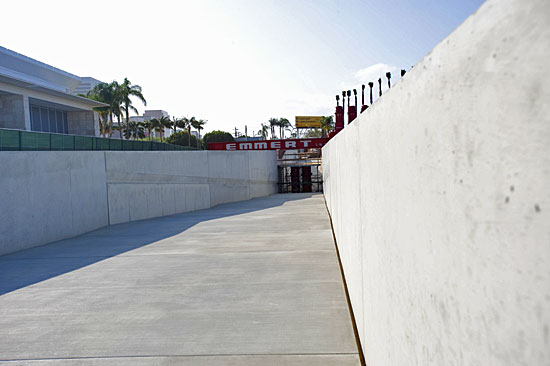
Visitors to "Levitated Mass" will walk down this channel, where the 340-ton boulder will be suspended overhead.
When artist Michael Heizer’s 340-ton boulder slowly rolls onto the grounds of the Los Angeles County Museum before dawn on Saturday, it will be parked alongside a meticulously constructed concrete trench that, away from the spotlight, has been put through its own complicated paces.
The Slot, as it’s officially known, is the 456-foot-long structure upon which The Rock will be permanently attached in the weeks ahead, a crucial element of the artist’s “Levitated Mass” installation. When completed, visitors will walk down this concrete trench with the boulder suspended 15-feet above. This, according to the artist, will create an illusion that the rock is floating, or levitating.
From the beginning, LACMA and its specialized team were under no illusion themselves that the task would be easy, given the unique engineering and safety issues involved with placing so much tonnage directly over the public noggin.
Months of strength testing, element analysis and 3D computer modeling were undertaken to satisfy everyone, including the City of Los Angeles, that The Rock would stay secure during an earthquake and true to Heizer’s vision.
“We don’t have more than one try. We can only get it right once,” says Ron Elad of the engineering firm Buro Happold, which was hired by LACMA to translate the artist’s design ambitions into achievable engineering principles. “Everything that is going to happen in attaching that rock was tested.”
David Lara, a spokesman for the Building and Safety Department, acknowledged some back-and-forth between the parties but added: “They provided what we needed and we provided what they needed.”
The entire slot structure was designed with the support of the rock’s weight in mind, including a 3-foot-thick concrete foundation and underground support of the walls adjacent to the rock’s mount. The aesthetics were further influenced by laws protecting disabled individuals. The channel’s length was calculated to create a slope gentle enough to allow for safe navigation by people in wheel chairs. Hand rails also were cut directly into the concrete walls.
The process for attaching the megalith, as LACMA likes to call it, will unfold out of public view, obscured by fences on the northwest corner of the museum’s campus, near Fairfax Avenue and Sixth Street. The trench itself is not even complete; construction was stopped 75-feet short to give the giant red transporter room to maneuver on Saturday, according to Meg Thomas of Aurora Development, the project’s manager.
If all goes well between now and then, here’s what Thomas says will happen next:
Within 10 working days, Emmert International’s specially-built transporter will be dismantled around the boulder, which will then be positioned by hydraulic lifts over the “rock chamber”—an area where two stainless steel plates jut across the top of the slot. With that accomplished, work will stop until the reclusive artist arrives from his Nevada home to determine the rock’s precise orientation between the plates.
The rock then will be permanently affixed through three methods. First, a high-density grout will be placed on the steel plates. Then, nine holes will be drilled through the plates and into the rock, about a foot deep. A high-strength epoxy will be injected into the holes, quickly followed by the insertion of pins, 1-inch in diameter. This technique is aimed at preventing the rock from lifting up or rolling over during an earthquake. Finally, six steel “wedges” will be placed around the rock to prevent side-to-side sliding. Since the wedges will be visible (unlike the pins), Heizer is designing wood models, which he’s expected to bring with him.
In all of this, Thomas says, the trick has been figuring out ways to attach the rock while complying with the artist’s intentions and the city’s instructions. “Half the art, in my opinion, is in its constructability,” she says.
That said, when it came to the aesthetic details of the slot, the artist has been exacting, as the man in charge of one of the slot’s defining characteristics—its precise concrete work—can tell you.
“He wanted razor-sharp corners” says Bill Hanson of Matt Construction, who was in charge of some 2,000 cubic yards of concrete. “It’s pretty difficult. You have to pay attention.” Heizer also wanted no visible joints or tell-tale signs of bolts under the concrete, also significantly raising the degree of difficulty.
Over the decades, Hanson, 65, says he’s worked on some pretty big “architectural concrete” projects, ranging from the Bonaventure Hotel in the mid-1970s to the Skirball Cultural Center in the mid-1990s. But “Levitated Mass,” it seems, may hold a special place of pride in a long career.
“I’m going to bring my seven grandkids to see it,” he says.
Posted 3/7/12
We know it’s only rock ‘n’ roll but…
March 6, 2012
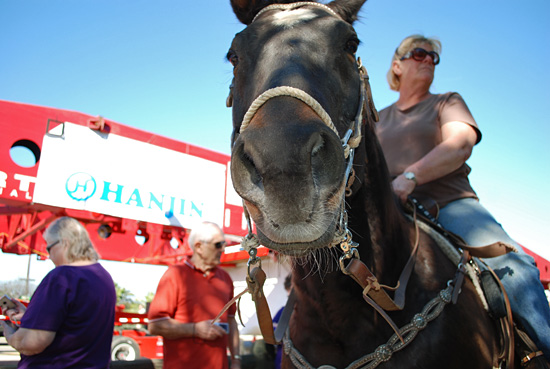
Don't expect to see any horses when The Rock arrives in Long Beach, its first urban stop in its journey.
It’s a long way to the top, as AC/DC would put it, but the big city star treatment is about to begin for The Rock.
After wending its way for more than a week through cow pastures, truck routes and far-flung suburbs, the 340-ton centerpiece of Michael Heizer’s new “Levitated Mass” sculpture is finally beginning the urban leg of its trip to LACMA.
From here on in, “it’s going to be a real rockapalooza,” predicts Blair Cohn, executive director of the Bixby Knolls Business Improvement Association, which will be hosting a daylong welcome bash on Wednesday in Long Beach. Pulled together at the last minute with the help of Long Beach City Councilman James Johnson, the party will feature food, games, live music and a DJ playing songs with the word “rock” in the title from noon until 7 p.m.
Cohn says song requests and ideas have been pouring in all week via email and Facebook. “It’s the talk of the neighborhood.”
The bash will mark The Rock’s first stop in a densely populated part of Southern California since last Tuesday when it left its quarry near Riverside. Riding in a massive red transporter and traveling only by night, it has mainly stopped on surface streets and lots on Los Angeles’ outskirts, and its reception has mostly been one of open-mouthed wonder.
On Wednesday, however, it will spend the day on Atlantic Avenue between 36th and 37th Streets in the urban heart of Long Beach. From there, it will move to Vermont Avenue near Harbor-UCLA Medical Center, then to Figueroa Street north of Florence Avenue near Exposition Park and finally to LACMA late Friday night and early Saturday morning.
Long Beach officials say they saw The Rock’s stop as an opportunity both for fun and culture.
“Right away, I took out my notebook and started brainstorming,” said Cohn. “Rock painting, pet rocks, Pop Rocks, Rocky Road ice cream. Rockstar energy drinks. Rock-Paper-Scissors tournaments.”
The party will feature all those attractions, plus two live bands and Bill Child, a disc jockey who performs as (dj)misterbill at many of the events sponsored by the business improvement association. Child says he will be spinning not far from The Rock on the patio of Patricia’s Mexican Food at 3626 Atlantic Avenue.
Cohn hopes Child will kick things off with Queen’s “We Will Rock You,” but Child’s personal favorite is “I Am A Rock” by Simon and Garfunkel.
Also likely to make the long play list, Cohn and Child say: “Rock Lobster” by the B-52’s, “Rockin’ In The Free World” by Neil Young, “Rock With You,” by Michael Jackson, “Rock You Like A Hurricane” by The Scorpions, “Like A Rock” by Bob Seger, “R.O.C.K. in the U.S.A.” by John Mellencamp, “Sorry For Party Rocking” by LMFAO and “I Wanna Rock” by Twisted Sister, not to mention AC/DC’s famous caveat to those who “Wanna Rock And Roll.”
“But we’ll try to keep it as fresh as possible,” Child says. “There’s going to be a lot to choose from. Just say that anything with ‘rock’ in it will be played tomorrow. I’ll be there for seven hours, so you can count on it.”
A rolling stone gathers new LACMA fans
March 4, 2012
Tony Gendrano has never visited LACMA, but on Saturday morning, 340 tons of the museum’s latest acquisition paid an eye-opening visit to him.
“I said, ‘What’s going on here?’” the retired Rowland Heights accountant marveled, opening the blinds of his upstairs window. There, on the other side of the pane, sat the top of the 2-story-high boulder that’s been making its way this week to the museum.
Covered in white shrink-wrap, it gleamed like the Matterhorn in its bright red transporter, so close that it seemed to be peeping into Gendrano’s master bedroom. Down the hill, traffic jammed and crowds jostled along Pathfinder Road, which runs along Gendrano’s back fence—and which, coincidentally, was The Rock’s designated pit stop for the weekend.
“We’d been following the news about the project, all the excitement,” said Gendrano, who spent 35 years at the county Department of Health Services before his 2009 retirement, “but I never thought it would get this close to our house. When I was still employed, I walked one time on the street near the museum, but for some reason, I just never went inside it.
“I will definitely go now, though. I’m curious,” he said.
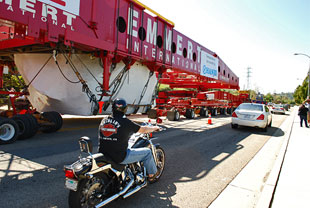
While hundreds of visitors intentionally dropped by Pathfinder Road to see The Rock, others came upon it accidentally.
The Rock’s 9-day odyssey across the Southland has been far more than a simple delivery from Point A to Point B. Since its late-night sendoff last Tuesday at a Riverside County quarry, the massive chunk of granite—part of “Levitated Mass”, a sculpture by earth artist Michael Heizer—has been gathering a whole new audience, both for LACMA and for art.
Gear heads have come to check out its transporter. Shutterbugs have taken its portrait. Schoolteachers have used it for lesson plans. History buffs have researched its provenance. Families have shown up with babies in blankets and grandparents in wheelchairs. Drunks have materialized at every stop, hollering and toasting. A Riverside County trucker proposed to his live-in girlfriend beside it. (“I wanted to give her a rock next to The Rock,” explained 35-year-old Ramon Vasquez III of Glen Avon.)
On Saturday morning, a man in a Rolling Stones t-shirt walked through the crowd calling it “Mick” (as in Jagger) and two Rowland Heights women rode up to it on horseback. Long lines of motorists drove by the transport apparatus, filming it on cell phones and yelling things at it.
“Roooooooooock!!” a carload of young men roared, revving their engine, as the boulder’s security detail looked mildly alarmed.
Many of the visitors say the spectacle has made them aware of the Los Angeles County Museum of Art for the first time; this has especially been the case at the early Inland Empire and East San Gabriel Valley stops. More than 60 percent of LACMA’s visitors come from within Los Angeles County, according to museum statistics, and so far, not one of the congressional districts The Rock has passed through has more than 500 paid LACMA members. By contrast, the Mid-Wilshire-to-Malibu congressional district in which LACMA is situated has more than 17,000.
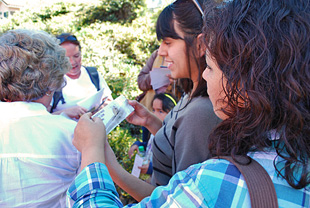
Taking advantage of the crowds, LACMA staffers passed out everything from bookmarks to free tickets.
“I can’t recall the last time I was at the museum, but I’ll probably go see this when it gets there,” said Irene Valenzuela, a purchasing agent for Smart & Final who was in the Rowland Heights crowd on Saturday with her husband, Art, and their granddaughter, Kaitlin Minton.
“I heard it cost, like, $10 million to purchase and transport it. For that kind of money, yeah, I want to check it out.”
LACMA officials didn’t engineer the enthusiasm, though they have come to view it as an opportunity as consciousness has built. Publicizing the move was initially tricky because permitting snags kept delaying the project. Also, several of the stopovers were on private property or in difficult-to-access locations.
Moreover, no one wanted the spectacle of the move to overshadow the finished sculpture. Until the boulder is fitted to a 456-foot-long concrete trench awaiting it at LACMA, it is only one component of Heizer’s artwork, which will allow viewers to walk underneath the megalith in such a way that it will seem to be levitating.
On the first night of The Rock’s journey, however, it became clear that this was one piece of public art that was destined to engage the public.
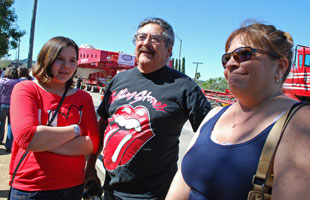
Rolling Stones' fan Art Valenzuela, with his granddaughter and wife, says LACMA's boulder should be named "Mick."
“What I really like is the way it’s making a public space,” observed Esther Amaya, a 20-year-old Cal Poly Pomona student discussing the boulder with her Whittier relatives at the Rowland Heights stop over the weekend.
“People are here talking, taking pictures, bringing their pets. Some are saying, ‘This is the stupidest thing I’ve ever heard of.’ Some are saying, ‘This is amazing!’ I think this is how you know it when you’re seeing great art.”
“Clearly, people are fascinated by it,” said LACMA Vice-President of External Affairs Terry Morello, noting that page views on the museum’s website have increased tenfold.
Docents have been on site at its stopovers since Wednesday, handing out informational bookmarks, free LACMA tickets and applications to NexGen, the museum’s free youth membership program. The museum also has reached out to schools with a downloadable “Levitated Mass” curriculum.
“We’ve easily given away hundreds of tickets,” said LACMA spokesman Scott Tennent, hustling to satisfy a crush of onlookers in Rowland Heights. “People seem so excited, not only about the artwork but also about the museum. Especially on the first nights, we met a lot of people who had no idea what LACMA was.”
Morello says that it is too soon to tell whether The Rock’s popularity will translate into increased financial support for the museum; the struggling economy has kept paid membership relatively flat for the last several years.
But museum officials have reason to be optimistic when it comes to increasing public involvement. In 2008, in concert with a major remodel, LACMA added another massive outdoor sculpture, an arrangement of antique street lamps by Chris Burden.
“Urban Light” is now an iconic Los Angeles artwork—and museum attendance has doubled in less than four years.
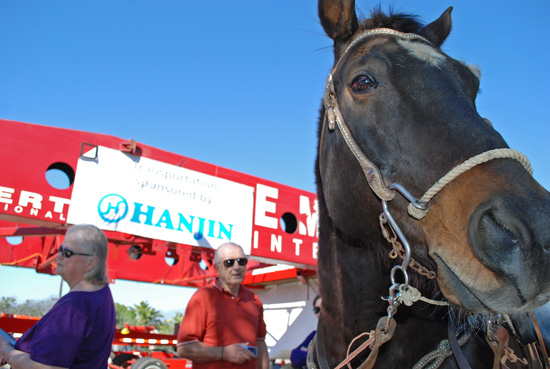
Among those in the diverse crowd in Rowland Heights was Guthrie, who trotted up with owner Debbie Scott.
Posted 3/4/12
And they say nobody walks in L.A.
March 2, 2012
There’s nothing like a brisk evening stroll to pump up your fitness. Ask Rick Albrecht. This week, he’s been averaging seven miles daily. In steel-toed boots. In the middle of the night.
Call it the Rock Walk. In a regimen that’s impressive even by Southern California standards, Albrecht and his coworkers have spent virtually every night since Tuesday on foot next to The Rock, carefully monitoring its 105-mile journey to LACMA.
“We may not look it,” the white-bearded 52-year-old joked as he waited to hit the road in a reflective vest and hardhat, “but we can out-walk just about anybody. Just by the nature of what we do, no matter what age we are, we’re in pretty good shape.”
A supervisor for Portland, Ore.-based heavy haul transporter Emmert International, Albrecht said that, even with breaks, he will personally cover 70 miles or more on foot by the time the boulder is delivered to the backyard of the museum in the wee hours of March 10.
And he’s not alone: More than a dozen crewmen will be walking beside him, escorting the 340-ton centerpiece of “Levitated Mass,” artist Michael Heizer’s new LACMA installation.
Although a handful of Emmert employees will be driving the massive red transport mechanism—a system of tractors, beams and cables within which the shrink-wrapped hunk of granite has been painstakingly cradled—the majority will be walking with radios beside the precious cargo, either remote-controlling various dollies or watching for potential slippage.
“Some jobs, you can ride alongside and watch from a pickup, but this is a specialized thing,” says crewman Joe Schofield, adding that he has mentally prepared himself to walk the entire distance, if necessary. “There’s so much going on that you have to walk or you can’t see it all.”
Schofield, also in his 50s, said the job has made him far more fit than most of his middle-aged neighbors in suburban San Gabriel, where he lives when he’s not traveling for his employer.
“I’ll do 30 miles on a bike when I’ve got nothing else to do,” said the bespectacled crewman, who says he thinks nothing of riding his beach cruiser to Long Beach and back just to see friends.
“People here say, ‘Oh, I’ve got to get to the gym.’ Oh yeah? Well, come out here and work with us a day. You won’t need to. When you’re handling big chains and moving blocks and walking five or ten miles a day, believe me, it does its thing to you.”
The boulder and its transporter together weigh about 1.2 million pounds; the move to LACMA from the Riverside County quarry where The Rock was blasted six years ago from the side of a mountain has been spread over 11 nights.
The cavalcade, which will move on surface streets through 22 cities and four counties, can only move between 10 p.m. and 5 a.m., and will not travel on Sunday. Its route is circuitous to avoid overpasses and bridges.
Five miles per hour is as fast as the apparatus will travel, so the pace isn’t bad, notes supervisor Charlie Prebble. And, he notes, the miles tend to fly by because the assignment is so high profile and critical. The transportation alone is costing millions of dollars, underwritten by corporate donor Hanjin Shipping.
Indeed, he says, this job’s workout is mild compared, say, to the 700-mile move they once did between Idaho and Montana, or the 14-miles they trekked in work boots, much of it in the sand, during a recent slow-speed delivery to the nuclear plant in San Onofre.
“You don’t get tired,” he says. “You can’t. You gotta keep moving. You only have from 10 to 5, so you’ve got to make the best of what you’ve got.”
Albrecht, whose brother Mark is the general manager of the project, said his family has been in the moving business for generations. “My father started out moving houses,” he says.
So what are Albrecht’s heavy-haul fitness secrets? Has he developed a stretching routine before his shift starts?
“Nope.”
Does he carbo load?
“Had a nice steak lunch today, that’s about it.”
What about blisters?
“After a while, you callous up.”
What does he do for variety in his off-hours?
“Ride Harleys.”
And when the sun comes up and another day of his marathon is over?
“You sit down and take your boots off and—ahhhhhhhhhhhhh. That feels good.”
Posted 3/2/12
Thoughts on a rock star
February 29, 2012
During the next week, you’ll surely see lots of pictures of a huge red contraption hauling a shrink-wrapped boulder along the streets of four counties, inching its way at night toward the Los Angeles County Museum of Art.
And I suspect some of you will be asking yourselves (and others), why all the fuss over a 340-ton chunk of granite from some Riverside quarry? This, you call art?
My answer to that, in a word, is yes. That said, I do understand some of the skepticism, which is why I thought I’d share with you what I find so inspiring—so artistic—about this monumental, privately-funded project.
The boulder is just one facet of a work called “Levitated Mass,” conceived by Michael Heizer, the reclusive Nevada artist who has dedicated himself for decades to massive undertakings using the offerings of the earth as his primary media. At LACMA, The Rock, as it has come to be called, will be positioned over a concrete trench that allows visitors to walk underneath, creating a sense that the boulder is levitating.
“Levitated Mass” and Heizer’s other big, outdoor projects are reminders to me of how small, physically, we are in the scheme of things. They almost demand humility and introspection. Indeed, the whole oversized effort—the transport, the engineering required to install the rock at LACMA, all of it—is part of the art to me.
Some people, of course, will always view Heizer’s LACMA work as simply a big rock. But to others, including me, it will represent something far more emotional and soulful. And that’s as it should be given the subjective nature of art—or, in this case, the art of nature.
The other night, in the chill air of Riverside County shortly before The Rock finally hit the road, I was struck by how the ambition of one man’s vision could not be realized without the specialized collaboration of so many others—the quarry workers, the hard-hatted crew responsible for moving the rock, the beaming museum executives who pulled together the funding. Then there were the scores of spectators who knew they were witnessing something special, something transcendent.
“This is a once in a lifetime experience, to see something like this,” said one. “This has been here for like 20,000 years, and now it’s art.”
My thoughts exactly.
(Click here for a map of where you can see The Rock as it makes its journey to LACMA.)
Posted 3/1/12
Finally, “The Rock” meets the road
February 29, 2012
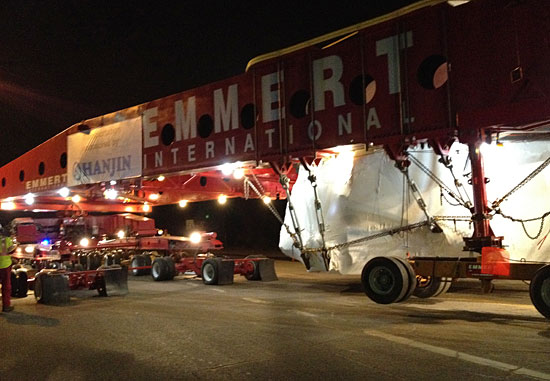
The Rock begins its nine-day journey to LACMA, where it will be used in Michael Heizer's "Levitated Mass."
With a round of applause and two mighty blasts of a truck horn, The Rock finally hit the road at 10:37 p.m. on Tuesday in what may be the most talked about slow-speed odyssey since O.J. Simpson’s Bronco snaked through the Southland’s streets.
The 340-ton boulder that is the centerpiece of “Levitated Mass,” Michael Heizer’s new LACMA installation took seven minutes just to make it out of the Stone Valley Materials Inc. quarry in Riverside County.
A crowd of several hundred cheered and shivered as the behemoth began its epic journey. Covered in white shrink-wrap to ward off taggers, it rode on a massive red transporter and looked, under the vehicle’s bright lights, like a well-lit iceberg.
“This is a once in a lifetime experience, to see something like this,” said Stan Ortman of Chino Hills, who spotted the boulder on his way home from work and stopped. “This has been here for like 20,000 years, and now it’s art.”
The Rock, as it affectionately came to be known, has been waiting for what seems like eons to head out to LACMA, where it will be positioned over a concrete trench in a manner that will make it look as if it is levitating.
That Thursday night’s festive send-off even happened is a bureaucratic miracle of sorts. Although millions of dollars in transportation costs are being underwritten by corporate donor Hanjin Shipping, the move required delicate and sometimes contentious negotiations with 22 cities and four counties. As early as Tuesday morning, some municipalities were still demanding various concessions from the museum in exchange for permits.
For the next nine days, The Rock will be cradled on its 299-foot-long, 27-foot-wide steel carriage as it travels on surface streets at speeds of less than 5 mph. Crews of workers will rush ahead to make sure utility and power lines are kept clear.
The Rock reached its first stop before dawn at a wide-open strip of private property at Mission Boulevard and Bellegrave Avenue in Glen Avon. It will spend all of Wednesday there before setting off in darkness on its next leg, which, if all goes according to plan, will get it as far as Mission Boulevard and Grove Avenue, near LA/Ontario International Airport.
(For a full LACMA “Gawker’s Guide” to The Rock’s trip, click here.)
On Tuesday night, several hundred people came by during the evening to bid The Rock bon voyage, including LACMA Director Michael Govan, Supervisor Zev Yaroslavsky, Jurupa Valley Mayor Laura Roughton, and Dan Johnston, who, as project manager for the quarry’s former owner, sold the boulder to Heizer.
Govan said that, when Heizer first set eyes on granite boulder, which had been dynamited from the side of the mountain, “he called me… and said it was the most beautiful rock he’d ever seen.”
Although Heizer, who is famously reclusive, was not in attendance Tuesday, Govan said he’d seen him earlier in the day at the artist’s home in Nevada. “He said there was nothing he could do to help move the rock,” Govan explained, “so he wouldn’t be here. But he’s excited. When we first started this, we weren’t sure it would actually happen. The engineering, the organization, all the permissions—there were a lot of doubters. But now it’s happening, and it’s going to be a real gift to the public. It’s going to be great.”
The crowd tended to agree.
Daniel Ponti, a Glen Avon photographer, said he had been “waitin’ months for that darn thing to move,” and checking its progress daily. Saul Gomez, 14, of Sunnyslope, said his father had alerted him to The Rock’s presence and sent him to look with his mom and his sister Samantha. “I’ve never seen anything like it,” the boy said. “It’s huge!”
Others were as amused as they were awestruck.
“Pretty big rock, huh?” observed Dave Sharp of nearby East Highland, a union employee whose wife, Leslie Hubbs, said she was the niece of the quarry’s former owner. “I think it’s crazy. It’s great, but it’s nuts.”
Stephen Vander Hart, the quarry’s current owner, said the boulder had been loaded since December and ready to roll since Saturday morning. All week, he said, bystanders had been coming by to check it out.
As the sun set Tuesday, commuters and neighbors gathered to pose with the boulder and buy Southern-style barbecue from an enterprising local chef. “We’re re gonna miss it,” said Vander Hart. “It’s pretty impressive. I think people are gonna get a kick out of seeing it out there on the road.”
The Rock will travel only at night. In addition to the first two stops in Riverside County, it will stop in Diamond Bar, Rowland Heights (it will be across the street from Pathfinder Community Regional Park both Saturday and Sunday), La Mirada, Lakewood, Long Beach’s Bixby Knolls neighborhood, Carson, and Los Angeles (near Exposition Park).
It will rest during the day and arrive at LACMA on Friday sometime before dawn. There, it will be positioned over the other half of Heizer’s artwork—a massive concrete trench on the Resnick Pavilion lawn.
Posted 2/29/12
LACMA “Rock” to roll next week 2
February 27, 2012
Los Angeles art fans may feel like they’ve been waiting since the Stone Age, but it looks like that 340-ton boulder heading for LACMA could be on the road as early as Tuesday, if not the following week.
The Rock, as it has come to be known, is to be the centerpiece of a massive outdoor installation by artist Michael Heizer, who purchased it seven years ago from a Riverside County quarry. It has been waiting there ever since while museum officials worked with a heavy-haul transport company to negotiate its passage from the Inland Empire to the Mid-Wilshire District.
“Nothing is set in stone yet, no pun intended,” said LACMA consultant Meg Spieker Thomas, but all signs are that The Rock’s departure is nearing.
It was scheduled to roll last August, but its progress has been fraught with postponements. First its transporter had to be custom built and then its movers had to plot a surface-street route that could handle a hunk of granite the size of a 2-story building.
The route finally was settled back in October, but then problems arose as word leaked that this would be an unconventional shipment, and the haulers began to negotiate permits with the 21 cities and four counties through which The Rock required passage. Most communities were accommodating, but a handful raised multiple issues. At various points, intervention was required from members of the Board of Supervisors.
Despite the fact that most of the roads being used are longstanding truck routes, Chino insisted that blueprints and repair records be extensively researched to prove that the transporter wouldn’t damage water pipes serving Chino Hills homeowners. Lakewood and Long Beach called for tree trimming to ensure the transporter wouldn’t sideswipe their landscapes. Diamond Bar and Chino demanded that core samples of their pavement be tested. Gardena wanted special assurances that if its street lights were damaged the city would be reimbursed.
“Heavy hauls move through these cities every night,” Thomas said. “People failed to understand that this one was just getting special attention because of the art factor and the publicity.”
But by this week, most, if not all, concerns had been addressed and state permits had been issued for a Tuesday, February 28, departure. Haulers have already shrink-wrapped the rock and loaded it onto its special transporter. Should some snag arise, preventing a Tuesday departure, Thomas said the move would probably be rescheduled for the following week.
The rock will travel only at night, escorted by eight California Highway Patrol officers. During the day, it will be parked and watched over by four security guards. Its layovers, with one possible exception, will last only a day and most will be in the middle of various roadways, with space on either side for traffic to detour around it. The epic journey is expected to take nine or ten nights, traveling at less than 10 miles per hour.
The public will be able to track its progress via LACMA’s web site or a special museum hotline that will be made public as soon as The Rock hits the road.
Updated 2/25/12
It’s official. LACMA announced Friday that The Rock will roll Tuesday at 11 p.m.
Transportation, made possible by Hanjin Shipping, will take about 11 nights, covering 22 cities and four counties. The heavier half of a massive outdoor artwork, “Levitated Mass” by Michael Heizer, the 340-ton boulder will eventually be positioned over a 456-foot-long concrete slot on the LACMA campus. As visitors walk through the slot, the boulder will appear to be levitating.
It is scheduled to arrive at LACMA in the wee hours of Saturday, March 10, and open to the public in the late spring or early summer. Those who want to follow its progress can check LACMA’s Rock hotline at 323-857-6262 for questions, or click here for updates. Want to check out the route? Click here.
LACMA “Rock” to roll tonight
February 23, 2012
Los Angeles art fans may feel like they’ve been waiting since the Stone Age, but it looks like that 340-ton boulder heading for LACMA could be on the road as early as Tuesday, if not the following week.
The Rock, as it has come to be known, is to be the centerpiece of a massive outdoor installation by artist Michael Heizer, who purchased it seven years ago from a Riverside County quarry. It has been waiting there ever since while museum officials worked with a heavy-haul transport company to negotiate its passage from the Inland Empire to the Mid-Wilshire District.
“Nothing is set in stone yet, no pun intended,” said LACMA consultant Meg Spieker Thomas, but all signs are that The Rock’s departure is nearing.
It was scheduled to roll last August, but its progress has been fraught with postponements. First its transporter had to be custom built and then its movers had to plot a surface-street route that could handle a hunk of granite the size of a 2-story building.
The route finally was settled back in October, but then problems arose as word leaked that this would be an unconventional shipment, and the haulers began to negotiate permits with the 21 cities and four counties through which The Rock required passage. Most communities were accommodating, but a handful raised multiple issues. At various points, intervention was required from members of the Board of Supervisors.
Despite the fact that most of the roads being used are longstanding truck routes, Chino insisted that blueprints and repair records be extensively researched to prove that the transporter wouldn’t damage water pipes serving Chino Hills homeowners. Lakewood and Long Beach called for tree trimming to ensure the transporter wouldn’t sideswipe their landscapes. Diamond Bar and Chino demanded that core samples of their pavement be tested. Gardena wanted special assurances that if its street lights were damaged the city would be reimbursed.
“Heavy hauls move through these cities every night,” Thomas said. “People failed to understand that this one was just getting special attention because of the art factor and the publicity.”
But by this week, most, if not all, concerns had been addressed and state permits had been issued for a Tuesday, February 28, departure. Haulers have already shrink-wrapped the rock and loaded it onto its special transporter. Should some snag arise, preventing a Tuesday departure, Thomas said the move would probably be rescheduled for the following week.
The rock will travel only at night, escorted by eight California Highway Patrol officers. During the day, it will be parked and watched over by four security guards. Its layovers, with one possible exception, will last only a day and most will be in the middle of various roadways, with space on either side for traffic to detour around it. The epic journey is expected to take nine or ten nights, traveling at less than 10 miles per hour.
The public will be able to track its progress via LACMA’s web site or a special museum hotline that will be made public as soon as The Rock hits the road.
Updated 2/25/12
It’s official. LACMA announced Friday that The Rock will roll Tuesday at 11 p.m.
Transportation, made possible by Hanjin Shipping, will take about 11 nights, covering 22 cities and four counties. The heavier half of a massive outdoor artwork, “Levitated Mass” by Michael Heizer, the 340-ton boulder will eventually be positioned over a 456-foot-long concrete slot on the LACMA campus. As visitors walk through the slot, the boulder will appear to be levitating.
It is scheduled to arrive at LACMA in the wee hours of Saturday, March 10, and open to the public in the late spring or early summer. Those who want to follow its progress can check LACMA’s Rock hotline at 323-857-6262 for questions, or click here for updates. Want to check out the route? Click here.
New library tells Topanga’s story, too
January 17, 2012
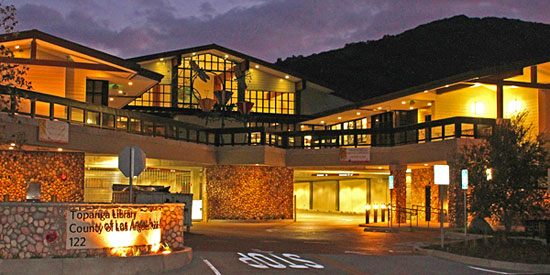
The new Topanga Library reflects the spirit and sensibilities of the artistic Santa Monica Mountains community.
It may not be easy to tell a book by its cover, but when the county’s newest library opens this weekend, visitors will have no trouble knowing which community’s stories are surrounding them.
From the design to the public artwork, the long-awaited Topanga Public Library, which will be dedicated on Saturday, is an organic outgrowth of the community it will soon serve.
“They tried to make it as homegrown as possible,” says Topanga artist Matt Doolin, who, with his brother Paul and his mother Leslie, created a circular tile mural of an idyllic Topanga landscape that will anchor the library’s main room.
The 11,293-square-foot, silver LEED-certified building broke ground in 2008 and has been in the works for more than a decade; for generations, residents of the mountain community had made do with other towns’ libraries and a visiting bookmobile. (Click here for a gallery of early construction work.)
Although Los Angeles County funded the $19.6 million project, it was clear from the start that the iconoclastic community, filled with environmentalists and artists, would insist on weighing in on the building’s aesthetic and carbon footprint.
“There are a lot of stakeholders in Topanga,” laughs Rebecca Catterall, former president of the Topanga Canyon Gallery and a 30-year-resident of the rustic enclave.
“There’s a sense of a spiritual connection there that’s not like any other place, and I think it’s important to the people,” agrees Norman Grochowski, who spent most of his career in Topanga and whose massive-yet-whimsical steel-and-ceramic book flowers bedeck the library’s entry.
“Topanga is a land within a land, a place far away.”
So a local design advisory committee was convened to determine the rustic “lodge” look of the North Topanga Boulevard building, and the library was built to the latest green construction standards.
Meanwhile, in accordance with county policy, one percent of the cost of construction was allocated for the incorporation of civic art into the project. A second local committee, this one pulled from the local art scene by the Los Angeles County Arts Commission, commissioned pieces by four local artists. (Click here for an extensive photo gallery of the of the library’s artwork on Green Public Art’s Flickr page.)
Catterall, who sat on the arts committee, says the group methodically culled 29 entries in search of artists who were both representative of the community and who worked on an architectural scale. Patricia Correia, a Topanga-based art dealer and former gallery owner who served with Catterall, says the artists were chosen first and then asked to make pieces for specific areas of the building.
“A lot of times in public art, people pick a beautiful sculpture and then find out it’s too small or too big.”
Some aspects of the new library ended up being literally rooted in Topanga: A podium, two Adirondackchairs, two rocking chairs and a picnic table were made from trees that had had to be removed during construction. That work, set in motion by Supervisor Zev Yaroslavsky’s office, was done by Don Seawater, whose California-based Pacific Coast Lumber Co. is a leader in the use of reclaimed wood and urban forestry.
Artist and art teacher Megan Rice, who did two papier mache sculptures for the library’s children’s section, also honored the fallen trees—two oaks and two pines—by using one of the stumps as the base for “A Great Tale,” which depicts a little boy reading to his faithful dog.
“I’ve lived in Topanga since 1956, and when I heard they were looking for artists with a vested interest in Topanga, I felt, ‘That’s me’,” says Rice, who was 5 when her parents moved to the community.
“My mother was the children’s librarian at Topanga Elementary School for eight or ten years, and I grew up with the bookmobile—in fact, in my early childhood, it was a very big part of my life because we had few neighbors, and for a long time my mother didn’t have a car, so getting a big stack of books there was a source of great excitement for me.”
Local potter Jim Sullivan, a resident since the early 1960s, remembered the Topanga childhood of his now-grown daughter when he designed the ceramic tile “rug” just inside the front entrance. “When she was in fourth grade, she went to the Adamson House inMalibu, and the docent stopped them at the front door and pointed to the threshold,” says Sullivan. “She said, ‘Does anybody know what that is?’”
Only Sullivan’s daughter, the child of a ceramist, knew that the design on the floor was a broken tile mosaic. When the guide explained that broken tile was often used in doorways because of ancient lore that it kept out evil spirits, Sullivan says his daughter became so excited that she begged him relentlessly to install similar mosaics in their own house.
Since then, he says, he has done a number of such installations, and when he heard about the library commissions, he felt a piece of broken-tile floor art would be perfect for Topanga’s new landmark. His 8-foot-wide piece, made entirely by hand, he says, depicts a spark growing into a flame of intellect and community.
All the artists who contributed work are established and well known in Topanga. The Doolins have done murals at local landmarks ranging from Disneyland California Adventure to public pools in South Los Angeles. Grochowski, who now lives in Crescent City, Ca., but visits Topanga several times a year, has shown work at LACMA and the Laguna Art Museum.
Rice’s work has been exhibited throughout California, and Sullivan, whose ceramics are in a number of private collections, has done historic restoration work from Malibu to Pasadena; for many years he co-owned Malibu Ceramic Works, a Topanga tile company that replicated historic tiles.
Correia says the work by Sullivan and the Doolins echoes Topanga’s long history as a center for ceramic artwork and the sculptures by Rice and Grochowski brought variety.
“There aren’t a lot of libraries getting built anymore,” she notes. “It was exciting, and we wanted to bring a three-dimensionality to the space, take it beyond just a big painting or a big mural outside.”
The new library “is incredibly important,” adds Correia.
“We don’t really have an everyday kind of communal place that isn’t a commercial space,” she says. “This is going to bring the community together in a way that deals with knowledge and culture and imagination. I can’t wait.”
The library’s grand opening will take place Saturday, January 21, at 11 a.m. The address is 122 N. Topanga Canyon Blvd.
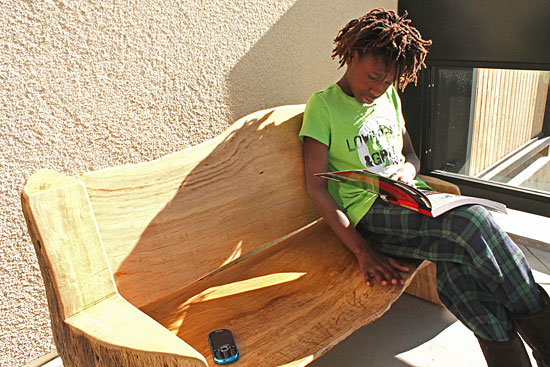
Some of the library's furniture, such as this bench, was crafted from trees that were cleared for the facility.
Posted 1/17/12




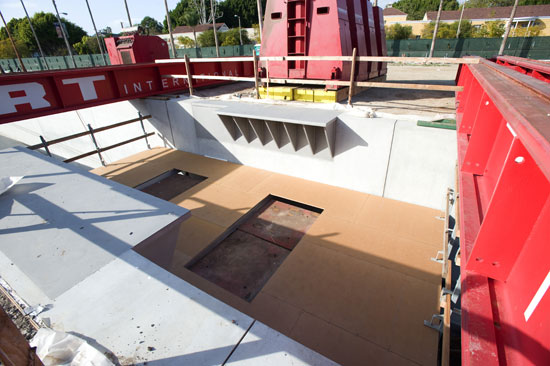
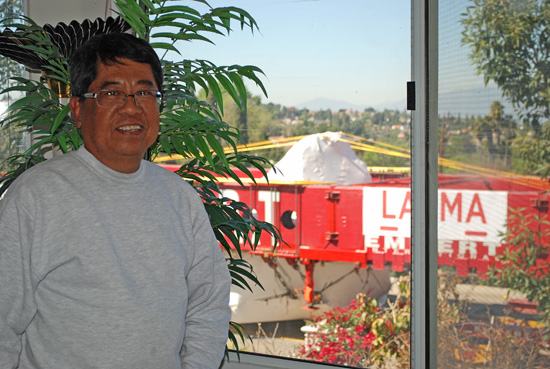
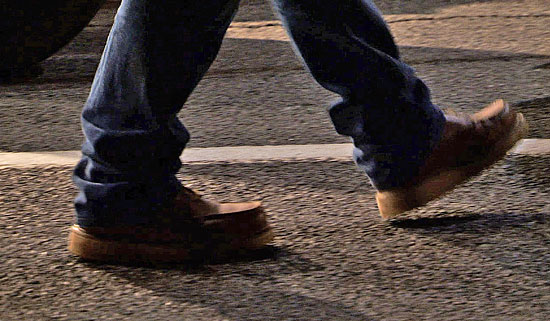
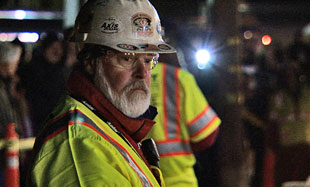
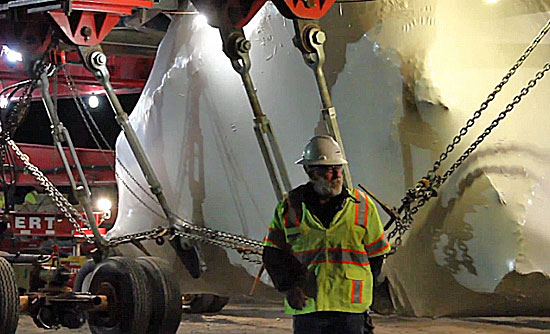
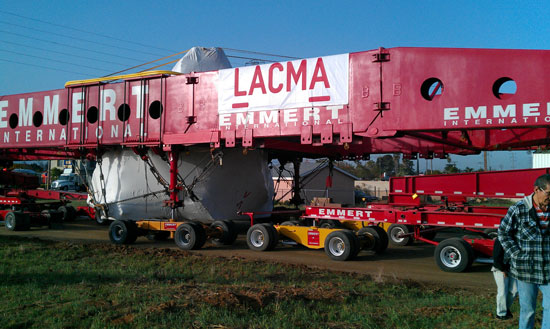
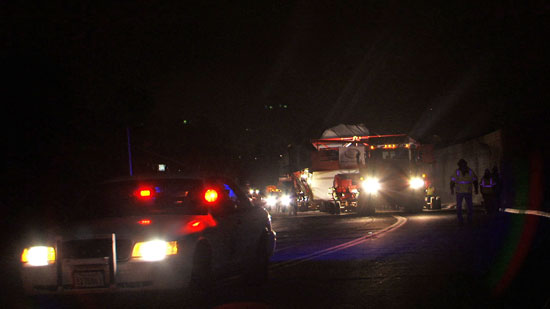
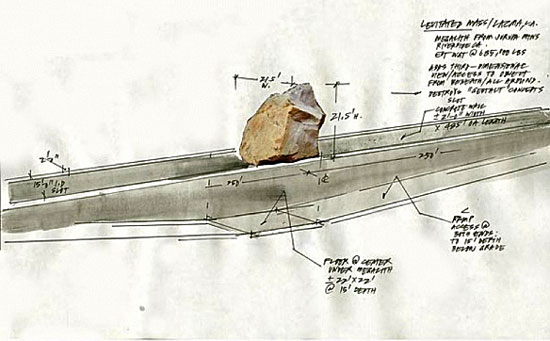
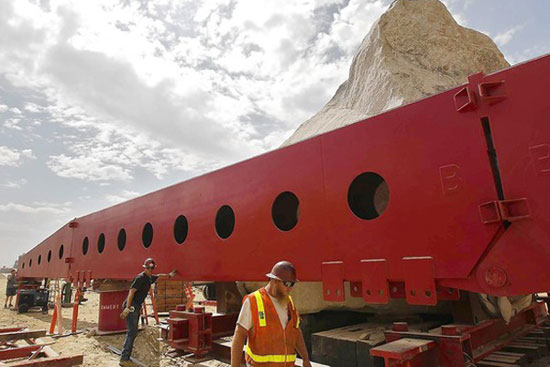

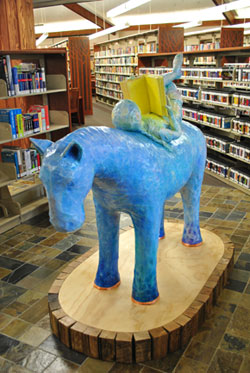







 405 bridge work causes a stink
405 bridge work causes a stink

